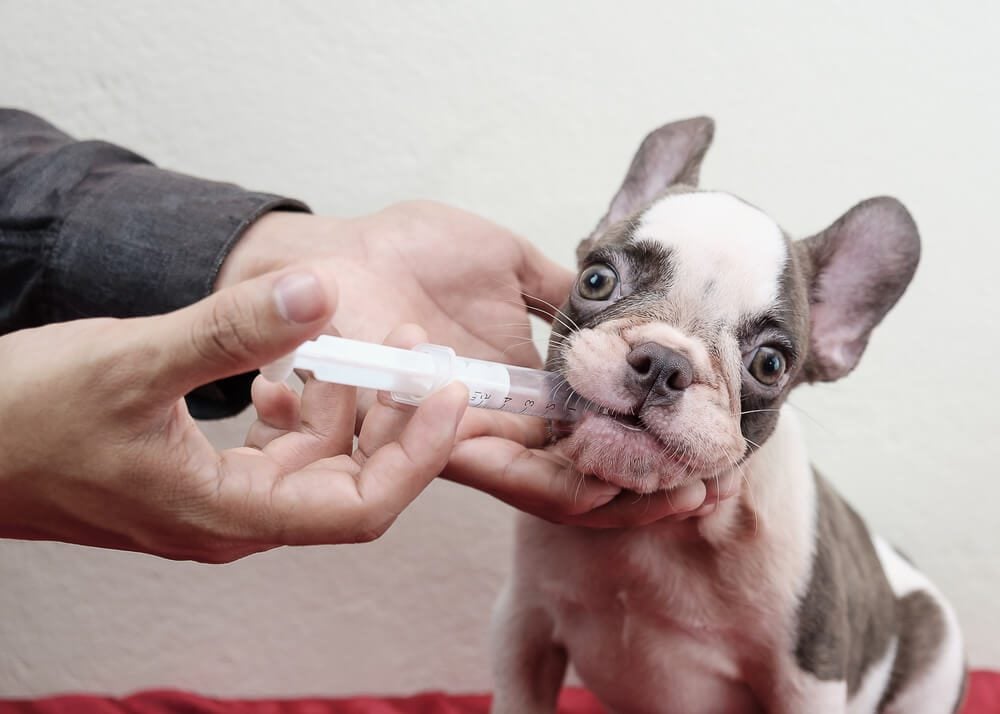A Guide to Galliprant for Dogs: Benefits, Dosage and More

Table of Contents
Modern studies suggest that Galliprant represents a “novel therapy for pain and inflammation.” According to the manufacturer, Galliprant is a first-of-its-kind NSAID that “targets the source of canine osteoarthritis pain and inflammation.”
Keep reading to learn why in 2019, Galliprant was voted as the best new veterinary product by the Veterinary Marketing Association and how it offers the same benefits as other non-steroidal anti-inflammatory drugs but with an improved and superior safety profile.
Can I Give My Dog Galliprant?

Yes, you can give your dog Galliprant. However, when creating your dog’s arthritis management plan, you need to talk to your trusted veterinarian. Galliprant is a new class of anti-inflammatory medication ideal for managing canine OA pain.
From a pharmacology standpoint, the active ingredient in Galliprant called Grapiprant is classified as a prostaglandin E₂ (PGE₂) EP4 receptor antagonist, a non-cyclooxygenase (COX)-inhibiting, and a non-steroid anti-inflammatory drug (NSAID) from the piprant class.
When to Use Galliprant for Dogs
As the manufacturer (Elanco) says, “OA can spoil the moments that matter.” Consequently, we can assume that Galliprant should be used to whenever a dog is experiencing arthritis-related joint pain and discomfort.
In the section above, we have described the complex pharmacological nature of Galliprant. To simplify things, let’s break this medication down.
Prostaglandin E₂ EP4 Receptor Antagonist. Prostaglandins are hormone-like lipids produced at the site of injury or infection in the body. They are involved in various body responses and by controlling inflammation, blood flow, and the formation of blood clots.
Prostaglandin E₂ (PGE₂) is involved in controlling inflammatory pain, vasodilation (dilation and expansion of blood vessels), and increasing the permeability of the blood vessels, amongst other things. PGE₂ exerts its effects via four receptors – EP1, EP2, EP3, and EP4.
The EP4 receptor plays an important role in mediating pain and inflammation. A receptor antagonist, either by binding to the receptor or changing the receptor’s shape, prevents the usual hormone or molecule from binding. This puts a stop to the cascade of effects that would occur should the substrate (e.g., PGE₂) bind with its receptor (e.g., EP4).
Non-cyclooxygenase (COX)-inhibiting. Cyclooxygenase-1 (COX-1) and cyclooxygenase-2 (COX-2) are enzymes integral in the formation of prostaglandins. Traditionally, NSAIDs block both COX-1 and COX-2 (e.g., aspirin).
While blocking COX-2 is great and results in a reduction in pain and inflammation, blocking COX-1 leads to impaired functioning of the kidneys, gastrointestinal tract (GIT), and blood clotting mechanisms. Namely, when inhibiting COX to achieve potent analgesic and anti-inflammatory effects, NSAIDs also trigger side effects.
Galliprant is non-COX inhibiting, meaning it does not prevent prostaglandin from being produced altogether. Instead, it prevents the inflammation-involved prostaglandins from fulfilling their pro-inflammatory effects.
Non-steroid anti-inflammatory drugs. Non-steroid anti-inflammatory drugs or NSAIDs are meds that have the ability to reduce pain, decrease fever, prevent blood clots, and, when used in larger amounts, manage inflammation.
In veterinary medicine, commonly used non-steroidal anti-inflammatory drugs (NSAID) include Carprofen (Rimadyl), Meloxicam (Metacam), Firocoxib (Previcox), and Deracoxib (Deramaxx). Long-term use of NSAIDs is associated with fewer and lesser adverse drug events than the traditionally used corticosteroids ( and cortisone).
Although more efficient in managing pain and inflammation, steroids mask the symptoms and, when used long-term, can suppress the immune system and adrenal glands. Galliprant is a non-steroid, meaning there is no risk of these otherwise common adverse reactions.
Benefits and Uses of Galliprant for Dogs
Galliprant targets pain and inflammation, thus being the perfect choice for managing canine osteoarthritis (OA). Arthritis develops due to cartilage break down which causes the bones to rub against each other leading to joint pain and inflammation.
At this time, canine osteoarthritis is incurable. However, pain management is an option that will improve the dog’s quality of life. Plus, the OA pain is likely to make your dog less active leading to weight gain, which will, in turn, place even more stress on the already damaged joints, thus exacerbating the problem.
Managing the pain by administering a drug like Galliprant for dogs can make your pet active and comfortable. Galliprant is safe for everyday use and can be combined with other pain medications and joint supplements.
Potential Side Effects and Risks of Galliprant for Dogs

Just because Galliprant is a novel non-steroidal anti-inflammatory drug with an improved safety profile does not mean it does not come with some side effects. Basically, all medications have the potential to trigger adverse drug events and unwanted effects.
These are the side effects associated with Galliprant in dogs:
- Gastrointestinal (GI) issues. Vomiting, appetite decreases, diarrhea, or soft stool (bloody stool/mucoid stool) are commonly observed side effects, but luckily, they are transient and self-limiting in most cases.
- Decreased serum albumin and total protein levels. Blood proteins are essential for transporting materials, and their decrease is not significant unless the dog already has a condition affecting their levels.
- Reduced tear production. In theory, sulfa-based medications have the ability to inhibit normal tear production, but in practice, such side effect was not established in dogs receiving Galliprant.
On rare occasions, a dog may be allergic to the active ingredient in Galliprant. The signs of allergic reaction warrant veterinary attention and include:
- Itchy skin
- Hives
- Facial swelling
- Breathing issues
Although generally safe and efficient, Galliprant is not universally suited for all dogs. This medication should not be used in:
- Dogs allergic or sensitive to the active ingredient
- Dogs with hypersensitivity to sulfonamide drugs
- Dogs sensitive or allergic to pork proteins
- Dogs with cardiac disease
- Puppies less than nine months of age
- Dogs weighing less than 3.6 kg (8 lbs)
- Breeding, pregnant, and nursing dogs
On the other hand, close monitoring and extra caution are required when using Galliprant in:
- Severely dehydrated dogs
- Dogs with pre-existing liver, renal, and GI disorders
Finally, concomitant use of protein-bound drugs with Galliprant must be avoided. This is because such drugs compete with the Grapiprant for the proteins, and the drug that does not get bound circulates freely in the blood, thus increasing the risk of overdoses and toxicosis.
Another thing to avoid is the concomitant use of Galliprant with other anti-inflammatory drugs like COX-inhibiting NSAIDs and traditional corticosteroids. If there is a need for concurrent use of additional pain medication, it must be a non-NSAID and non-corticosteroid analgesic.
Galliprant Dosage for Dogs
The recommended dose of Galliprant for dogs is 0.9 mg per pound (2mg/kg) of body weight once a day. It is always advisable the give the lowest effective dose for the shortest period of time, but there are individual variations.
The Galliprant chews are available in three strengths – 20 mg, 60 mg, and 100 mg tablets. The 20 and 60 mg are scored and can be easily broken for easy calculation in half-tablet increments. On the other hand, the 100 mg tablets are not scored and must not be crushed or broken.
Here is a short explanation of how many Galliprant tablets or half tablets your dog needs based on body weight:
- Dogs weighing between 8 and 16 lbs (3.6-6.8 kg) need a half tablet of Galliprant 20 mg
- Dogs weighing between 15.1 and 30 lbs (6.9-13.6 kg) need one 20 mg Galliprant tablet
- Dogs weighing between 30.1 and 45 lbs (13.7-20.4 kg) need a half tablet of Galliprant 60 mg
- Dogs weighing between 45.1 and 75 lbs (20.5-34 kg) need one 60 mg Galliprant tablet
- Dogs weighing between 75.1 and 150 lbs (34.1-68 kg) need one tablet of Galliprant 100 mg
- Dogs weighing between150.1 and 220 lbs (68.1-100 kg) need two tablets of Galliprant 100 mg
The Galliprant tablets feature a dog-friendly pork liver flavor which makes the administration easy. The absorption of Galliprant varies greatly based on whether it is administered with food or on an empty stomach. However, the manufacturer does not specify which method is preferred. To ensure the safe use of Galliprant, it is best to talk to your trusted veterinarian.
If you accidentally forget to give your dog its dose of Galliprant, do not double up on the next administration. Either skip the missed dose in completely or give it as soon as you remember and then continue with the regular dosing schedule.
In case of accidental ingestion or if you suspect a Galliprant overdose, contact your trusted veterinarian as soon as possible. When used in doses 15x larger than the recommended, Galliprant does not cause kidney or liver toxicity. However, an overdosed dog would still need symptomatic therapy and supportive care.
Galliprant for Dogs Usage Guidelines
When using animal drugs, your veterinarian’s role is critical. In the case of Galiprant, you will need a prescription and using instructions.
For example, before recommending Galliprant, the vet will consider any other drugs your dog is receiving at the moment. This is because Galliprant drug interactions are possible. To be more specific, Grapiprant tablets can interact with:
- Other anti-inflammatory meds like COX-inhibiting NSAIDs and corticosteroids
- Protein-binding meds (anticonvulsants and behavioral medications)
Galliprant is fast-acting and achieves effective pain management in between 1 and 2 hours after administration. However, it may take up to 14 days before you can see an improvement in your dog’s arthritis condition.
If switching to another non-steroid anti-inflammatory drug or planning to add corticosteroids to the management strategy, the veterinarian will recommend wash out – a specific time frame after discontinuing the Grapiprant tablets and before starting the new medication.
During long-term Galliprant use, the vet will suggest regular follow-ups and appropriate monitoring in terms of blood works (complete blood cell counts and biochemistry profiles).
To avoid overdose issues and accidents, always store Galliprant on a secured location, out of reach of children and out of reach of dogs and other pets (Galliprant is not FDA approved for use in cats). In case of accidental ingestion by humans, call your physician immediately.
If you are into holistic veterinary medicine and prefer a more natural solution for your dog’s arthritis pain, you should try CBD oils and products. Cannabidiol (CBD) is safe for canine use and manages the two aspects of osteoarthritis – pain, and inflammation.
When dealing with an arthritic dog, we suggest using CBD products from the Honest Paws Mobility Collection. The Honest Paws Mobility CBD oil is full-spectrum and enriched with turmeric as a natural anti-inflammatory agent. Additionally, it comes in a handy dropper bottle for simple dosing and use.
In addition to CBD oil, the Honest Paws Mobility Soft Chews feature joint-friendly ingredients like chondroitin sulfate, glucosamine HCL, hyaluronic acid, and Boswellia serrata powder. For convenient use, they are poultry-flavored and soft textured (good for seniors).
Our Final Thoughts on Galliprant for Dogs

Grapiprant tablets, or Galliprant for dogs, is a safe yet efficient medication that targets pain and inflammation. Patented and marketed as an industry-first, Galliprant is the ideal choice for treating joint pain and discomfort associated with osteoarthritis.
If your canine companion is starting to have trouble running up and down the stairs or showing other signs of osteoarthritis pain, Galliprant is just what you need to help ease their joint pain.

















